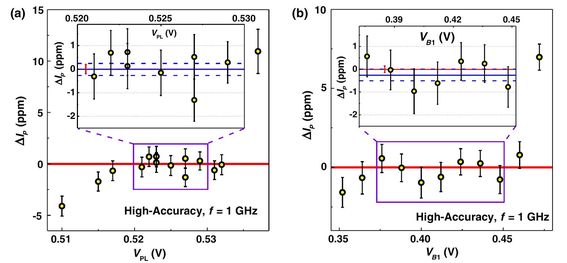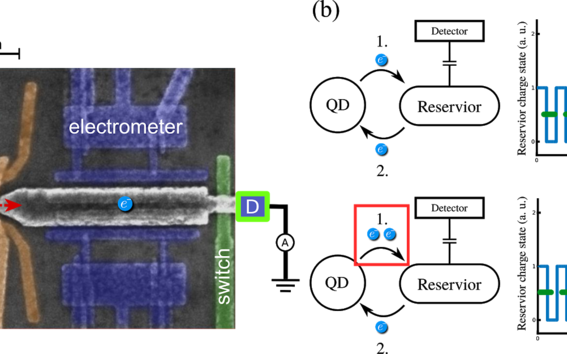Silicon quantum electronics

Single-electron current source
Our rigorous long term goal is to find a high-yield (100 pA) and metrologically accurate (10 ppb uncertainty) current source which could be used to redefine the unit of electric current, the ampere. This would revolutionize the International System of Units (SI) and allow for the possibility to compare the values of the Planck constant and electron charge in different quantum measurements with a stringent accuracy. In this so-called quantum metrological triangle experiment, the voltage is acquired from the ac Josephson effect, resistance from the quantum Hall effect, and current from the single charge pump. The Ohm’s law is then used to compare the fundamental quantities of nature.
In the past, we have studied the so-called sluice, i.e., a flux-assisted Cooper pair pump. We were able to pump as high current as 1 nA but with uncertainty down to a few percent, which is not enough for triangle measurement [Vartiainen et al., Appl. Phys. Lett. 90, 082102 (2007)]. We have also been working on SINIS-turnstiles [Nature Phys. 4, 120 (2008)] and silicon single-electron turnstiles [Appl. Phys. Lett. 92, 212103 (2011)]. However, the current experiments are carried out with silicon single-electron pumps (see next section) which are even more promising to be the new current standard.

Figure. Artistic illustration of the electron pump of [Nano Lett. 14, 3405 (2014)]. Figure credit: Heikka Valja.
Silicon single-electron pump
In the last half century, silicon technology has became the backbone of modern electronics industry. At low temperatures, metal-oxide-semiconductor field-effect transistors (MOSFETs) exhibit unique properties: with metallic gate stacks, localized conducting regions can be defined, where the Coulomb repulsion specifies the charge carriers on the island. These localized islands are called quantum dots. The benefit of employing a semiconductor such as silicon is that the tunnel barriers are voltage tunable opposed to fixed insulating layers in metallic single-electron pumps. Also it allows higher charging energies, which prevents pumping errors.
In our previous work done in collaboration with Andrew Dzurak’s group at UNSW, we used a single quantum dot to periodically transport single-electrons, creating a 80 pA quantized current with 50 ppm relative uncertainty [Nano Lett. 14, 3405 (2014)]. Together with UNSW and NPL, we improved this result to 160 pA with below 0.27 ppm [Phys. Rev. Applied 8, 044021 (2017)]. This single-electron pump is a potential candidate for the future electric current standard. In addition to high-precision measurements, we have demonstrated three-waveform bidirectional pumping [Sci. Rep. 6, 36381 (2016)].

Figure. High-accuracy measurements of the deviation of the pumped current from the ideal value as a function of (a) plunger gate voltage and (b) tunnelling barrier [Phys. Rev. Applied 8, 044021 (2017)].
Error counting and correction
Charge sensing in single-electron pumps benchmarks deterministically the pumping accuracy, because tunneling events can be monitored. Previously, we used a silicon single-electron transistor to observe electrons emitted from a quantum dot [New J. Phys. 17, 103030 (2015)]. We counted every electron tunneling event and observed that the results are consistent with direct current measurements. However, we could not use this device of error counting in practice since the single-electron transistor was very weakly coupled to the pump dot. Currently, we use a superconductor aluminum single-electron transistor to improve the detector sensitivity.
Our goal is to realize high-speed error counting, where the charge sensor only detects those bidirectional pumping events, when an electron is not captured or emitted by the quantum dot. The periodically pumped single electrons accumulate and deplete a reservoir island which is strongly coupled to the charge sensors. When the loading-unloading period is shorter than the single charge detection time, the resulting signal is an average of the two charge states. Rarely, but if one electron transfer fails, the signal average shifts, indicating an error. This technique gives in situ estimation for the pumping accuracies.

Figure. (a) False-color micrograph of an error counting circuit and (b) error counting schematics with direct-current electrometers.
Coherent spin pumping
Promising capabilities of quantum computation makes it an attractive and inspiring field of research. That is why our long term goal here is to create a scalable prototype of the quantum computer elementary cell.
Our previous work on the electron pumps can be used as a basis for the spin qubit manipulation. A qubit is a two-state quantum-mechanical system typically represented with a Bloch sphere. Using a single electron spin in solid state as a qubit was first proposed in 1998 by Loss and DiVincenzo. The MOSFET fabrication technology has finally advanced to the stage that it is now feasible to fabricate devices small enough to routinely manipulate single-electron spins, thus opening up the field of spin-based solid-state quantum computing.
We aim to use silicon quantum dots similarly to the previous electron pump devices with additional external magnetic field and electron spin resonance lines. Silicon is especially important here since Si-based spin qubits currently hold the longest spin coherence times, with spin dephasing times exceeding 28 ms shown by our collaborators [Nature 526, 410 (2015)]. They also achieved the fault-tolerance threshold for the surface code in readout and single-qubit control fidelities. Silicon spin qubits may provide a promising avenue as coherence times matter in large and complex quantum systems.
- Published:
- Updated: